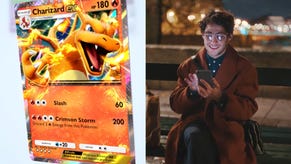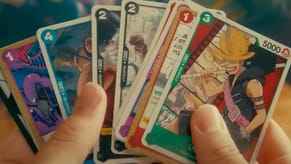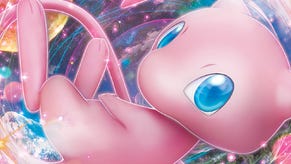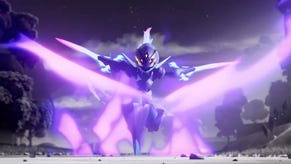10 best Fire-type Pokémon cards
Hot picks.
The best Fire-type Pokémon cards have always been hard-hitting, aggressive attackers since Charizard and Arcanine from the Pokémon TCG's Base Set.
Despite this, Fire also has had a large number of Pokémon cards that play more of a support role, never attacking unless absolutely necessary. We’ve even seen Fire-type control decks!
Best Fire-type Pokémon cards
- Pyroar (FLF 20)
- Arcanine ex (LM 83)
- Flareon (PLF 12)
- Blaziken (RS 3)
- Magcargo (DX 20/CES 24)
- Gardevoir ex δ (DF 93)
- Volcanion-EX (STS 107)
- Reshiram (BLW 113)
- Blacephalon-GX (LOT 109)
- Reshiram & Charizard-GX (UNB 194)
We’ve scoured the list of every Fire-type Pokémon card printed to date - and there’s a lot of them - in order to find the most influential and powerful Fire-type Pokémon cards.
1. Pyroar (FLF 20)
A wall of flames

Pyroar is one of those interesting Pokémon that hasn’t received much love in the trading card game, but when it’s powerful, it’s truly dominant.
Soon after its release in 2014, Michael Pramawat took the Royal Pokémon to a second-place finish at the US National Championship. His deck would focus around Pyroar FLF 20’s Intimidating Mane ability, which prevents all damage done to it by attacks from your opponent’s basic Pokémon. In a world overrun with mighty basic Pokémon-EX, Pyroar had the capability to shut down your opponent’s entire deck if they didn’t play an evolution Pokémon as an out.
After Pramawat’s stellar run, Pyroar continued to see play in the 2014-2015 season, often paired with the likes of Seismitoad-EX FFI 106 or Charizard-EX FLF 12. It saw renewed success in the Expanded format in a deck focused around Robo Substitute PHF 102 and Lillie’s Poke Doll CEC 267, aiming to win via a war of attrition, grinding out the opponent’s resources until they eventually had none to be able to attack with. Pyroar’s role in the deck was to act as a wall that the opponent had to either punch through or find a way around - which wasn’t something every deck could easily do!
2. Arcanine ex (LM 83)
Overrun the competition

Compared to Fire-type Pokémon cards nowadays, Arcanine ex LM 83 may not seem like much, but it was an absolute threat during the 2005-2006 season. Yancine Sekkoum managed to pilot this little fire dog to a Top 16 finish at that season’s World Championship.
Sekkoum’s deck focused around early aggression with Arcanine ex’s Overrun attack, carefully choosing which Pokémon on your opponent’s Bench to damage. The deck also played a bevy of disruption with a full four copies of Energy Removal 2, along with some number of Battle Frontier and Cursed Stone. Some players, like Sekkoum, even played Solrock LM 25 and Lunatone LM 20 in order to shut Fire-type and Colourless-type Pokémon out of using their Poké-Powers.
If that wasn’t enough, Arcanine ex has the attack Flame Swirl, doing 100 damage at the cost of discarding two Fire Energy or one React Energy. Normally, opting to discard the two Fire Energy would mean you couldn’t repeat this turn after turn, but giving the player an option to instead discard one React Energy caused very few Pokémon to remain safe after being hit with Bench damage from previous Overruns.
3. Flareon (PLF 12)
Swinging with a vengeance

A classic since it first hit the Pokémon TCG scene in ‘99 in Jungle, Flareon saw many iconic cards through the years, but truly rose to soaring success with its release in 2013’s Plasma Freeze. Known for its Vengeance attack, Flareon PLF 12 does more damage for every Pokémon in your discard pile.
Its first success was in Jimmy Ballard’s ‘World War Z’ deck, featuring Zoroark BLW 71 and other Eeveelutions at the 2012-2013 US National Championship, but really rose to the occasion off of Dylan Bryan’s Top 16 finish at the 2012-2013 World Championship. Flareon would slowly disappear into the background for the next year of Standard, but would remain a snowballing force to be cognisant of if an Eevee was ever played down.
Starting in the 2014-2015 season, however, Flareon would see more and more play due to the popular item Battle Compressor, which discarded any three cards from your deck. This led to very quick and powerful attacks, a strategy that would carry over to the Expanded format for a number of years - often partnering with Vespiquen AOR 10.
4. Blaziken (RS 3)
Let’s do that again

First of its kind and the start of a long lineage of energy recursion effects, Blaziken RS 3 is one of the most influential Pokémon cards to have been released in the game.
Its Firestarter Poké-Power allows you to attach one Fire Energy from your discard pile to one of your benched Pokémon. While this doesn’t seem like much, especially on a Stage 2, the format at the time of its release was quite a lot slower. When paired with Rayquaza ex DR 97, you could swing for 80 to 120 damage every turn to KO nearly anything in your path.
Blaziken would go on to be the most dominant deck of the 2003-2004 season, as well as one of the strongest contenders for the 2004-2005 season - even taking Chris Fulop to a second-place finish at the 2003-2004 World Championships.
5. Magcargo (DX 20/CES 24)
Smoothing out the rough spots

This one is cheating a bit; while Magcargo DX 20 and Magcargo CES 24 are not quite the same card, the Celestial Storm printing was a spiritual successor to the Deoxys printing with updated HP and damage.
Magcargo DX 20 was one of the largest consistency engines the Pokémon TCG has ever seen. Its Smooth Over Poké-Power would allow you to search your deck for any card, shuffle your deck, then place the chosen card on top of the deck. You could pair this with various cards that allowed you to draw one to three cards. This meant you could draw into any card you wanted every turn for the entire game.
Popular cards paired with this printing include Ludicolo DX 10 and Dark Tyranitar RR 19. The Celestial Storm printing of Magcargo also saw similar strategies and uses, popular in Zoroark-GX SLG 53, Granbull LOT 138 and Buzzwole FLI 77 decks.
6. Gardevoir ex δ (DF 93)
What’s that doing here?

Okay, if the last one wasn’t cheating, this one definitely is. Since when was Gardevoir a Fire-type Pokémon card? Since November 2006 when it was printed in ex: Dragon Frontiers. Dragon Frontiers was printed as part of a block of expansions set in the Holon region, a TCG-only region where scientists were heavily researching Mew and the powerful effects of crystals around the region, which seemed to change the types of Pokémon.
Gardevoir ex δ DF 93 was a part of perhaps the best deck to never see major play at an event: Scythe. The deck was created by Kevin Nance prior to the 2006-2007 US National Championship and featured not just Gardevoir ex δ, but also Swampert ex CG 98 and Scizor ex UF 108 - truly a hodge-podge of attackers.
The deck would often aim to lock the opponent’s Pokémon through Gardevoir ex δ’s Imprison Poké-Power, then use Swampert ex’s Energy Recycle Poké-Power to return energy into play, and finally close the game with a tanky Scizor ex. A pair of intimidating players at the time, Kevin and his brother Erik tested the deck thoroughly in the summer prior to the National Championship, in which Kevin won every game.
Unfortunately, the deck would barely see the light of day, as Kevin had to make the decision whether to attend the tournament or church camp. Erik, heartbroken that he couldn’t attend the event without his younger brother, also chose not to make the trek to Columbus, OH. The two, however, did leak the deck to one other player, who did not get appropriate testing in with the deck prior to the event. The deck was lost to history until Cara Emily Querin, a notable historian in the Pokémon TCG community, worked with the brothers to recreate the list from scratch the best they could in 2014.
If this isn’t convincing enough, Gardevoir ex δ saw a commanding domination of Japan’s ADV1 to PCG9 sets, which equated to our ex: Ruby & Sapphire through ex: Power Keepers (RS-PK) format due to similar reasons: being able to use Imprison to lock down your opponent’s board, creating inescapable board states while slowly grinding out damage and taking prize cards. This domination would continue until 2020, when revisiting the format would grow in massive popularity globally due to the pandemic.
7. Volcanion-EX (STS 107)
It’s like a sauna in here

One of the marquee Pokémon for XY: Steam Siege, Volcanion-EX STS 107 burst onto the competitive scene with explosive might.
The set was first legal for the 2016 World Championship, where many players weren’t expecting it to have much of an impact. They, however, were not expecting for Volcanion-EX to finish both 10th and 11th. This finish would propel the deck to top finishes at many major tournaments for the next couple of years.
The deck’s success hinged on Volcanion-EX’s Steam Up Ability, boosting damage of your basic Fire Pokémon’s attacks by 30. Steam Up also stacked, allowing you to attack for up to 120 additional damage. At this point in the game, the additional damage let you KO nearly anything in the format.
The deck’s success was crowned with Pedro Eugenio Torres’s win at the 2017-2018 Oceania International Championship.
8. Reshiram (BLW 113)
This is getting outrageous

Reshiram BLW 113 was one of the first full-art Pokémon cards to be printed in the TCG, paired with Zekrom BLW 114 from Black & White’s Base Set. This ushered in the era of “Big Basics”, a period in the game commanded by basic Pokémon with high HP and damage output.
Reshiram would see itself featured as the main attacker in several decks, being paired with Typhlosion HS 110, Emboar BLW 20 and many others. Due to the double colourless requirement of its first attack, Reshiram BLW would also be used as an inclusion in many decks for a Fire-type attacker - ranging from multi-typed toolbox decks to Donphan HS 107 decks to even Zekrom BLW-based decks.
This trend of being an easy inclusion would continue until the card eventually rotated for the 2015-2016 format.
9. Blacephalon-GX (LOT 109)
Don’t lose your head

In an era of the TCG headlined by Ultra Beasts, Blacephalon-GX was a top competitor for the entirety of its Standard lifespan.
Often paired with Naganadel LOT, the deck would seek to flood the board with energy every turn, only to send mass amounts of it to the Lost Zone - Pokémon’s version of an “exiled” or “removed from play” area of the board.
You could also escape common awkward positions with Blacephalon-GX’s Burst GX attack, a powerful attack that could only be used once per game. This unique attack allowed you to discard one of your prize cards and attach it to one of your Pokémon if it happened to be an energy card, which counted towards taking your prize cards to win the game.
While the deck saw success at the hands of many players, Zach Lesage and Iyla Sutherland were some of the more prominent users.
10. Reshiram & Charizard-GX (UNB 194)
Twice the fun

Perhaps the best Fire-type Pokémon card of all time, Reshiram & Charizard-GX UNB 194 - better known to the overall community as “ReshiZard-GX” - also claims a title as one of the pillars of the Tag Team-era of the TCG. This period was based around Tag Team Pokémon-GX, cards that featured two or more Pokémon teaming up on a single, powerful card. These cards were so strong that they gave up three prize cards on knockout.
Reshiram & Charizard-GX encapsulated this with the ability to dish out up to 300 damage in a single attack and 230 damage on a regular basis. Paired with staple support like Welder UNB 214 and Firey Flint DRM 76, this deck could get going with minimal effort.
In the first major event where these cards were legal to play, 2018-2019 Champions League Kyoto, Reshiram & Charizard-GX was featured in 25 of the top 64 decks. This was mimicked stateside by being a part of 24 of the top 64 decks of the 2018-2019 Madison Regional Championships, with the exact same list placing 2nd, 3rd, 6th, 10th, 23rd and 30th.







